
I really had no thought of writing an essay about what I considered the least interesting of the crystalline quartz varieties: rock crystal. That is, until a friend gave me a gift of a beautiful "coffee table" book called Rock Crystal Treasures: From Antiquity to Today. The breathtaking pictures and well researched text served well, to give me a needed "attitude adjustment".
The term, rock crystal, in use today, derives from the Greek word "krystallos" meaning - ice. In a treatise written around 300 BCE, Theophrastus (a pupil of Aristotle) explains the origin of rock crystal as being from ice that forms at such a high altitude, and therefore such a cold temperature that it was incapable of melting. This idea held sway until the 17th century when large deposits were located in Brazil, an obviously warm location. Today's major sources are Brazil and Madagascar with important secondary deposits in many other places including Arkansas and New York in the USA.

The Greeks were not the
first appreciators of this gem, however. Babylonians circa 2000 BCE
were advised that owning amulets or seals of rock crystal would
increase a man's wealth and possessions. Making collections of rock
crystal specimens with what were viewed as metaphysically important
inclusions was a pasttime of the wealthy in ancient China. These
items, purchased for purposes of contemplation and spiritual
enlightenment, were sometimes gained at great price -- as there are
records of rich men spending themselves into ruin to obtain the best
pieces.
Included quartzes also have a small share of today's commerce: with over 40 minerals known to occur as inclusions in quartz there are still plenty of specimens for the interested collector.
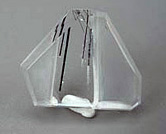
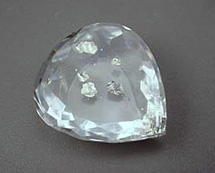
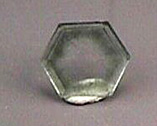
Rock crystal balls and skull carvings have long been given special significance in divination and necromancy. These artifacts have an enthusiastic audience in today's world, although cheap glass imitations abound. (By the way, the doubly refractive nature of quartz makes a dual image visible through them, not seen with glass). Early Christian art makes frequent use of rock crystal to symbolize purity, by its association with the Virgin Mary or angelic figures in paintings, tapestries and other art objects.
Jewelers from earliest times until today have used rock crystal liberally. Some of the most well known and photographed examples include Edwardian, Art Noveau and Art Deco pieces in museum collections.
In today's gem market, the place of rock crystal is a modest one. New facetors often choose it as an inexpensive, yet natural, practice material and carvers appreciate the availability of large, inclusion free pieces.
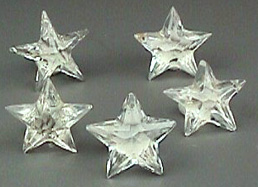
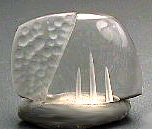
For the last several decades colorless quartz has been made in laboratories for use in communications and electronic equipment. Although colored synthetic quartzes are something to worry about when purchasing amethysts or citrines, natural rock crystal still reigns for gem use, as it is cheaper and more abundant than the man made version.
Gemological Properties:
Fluorescence: none